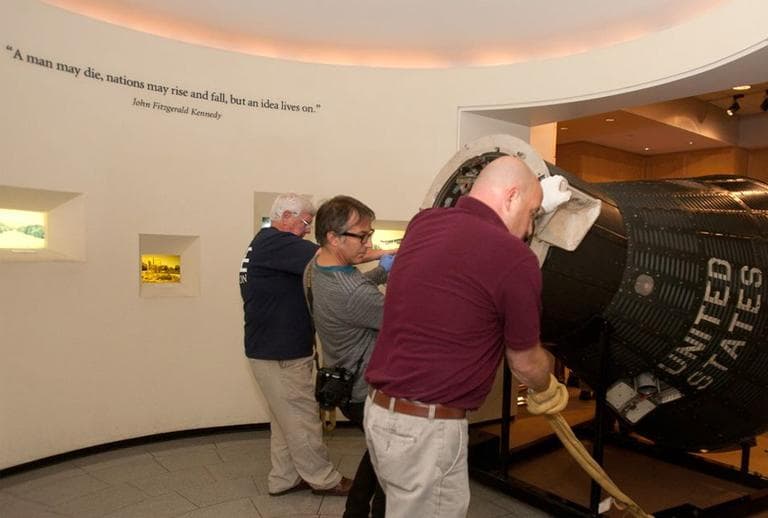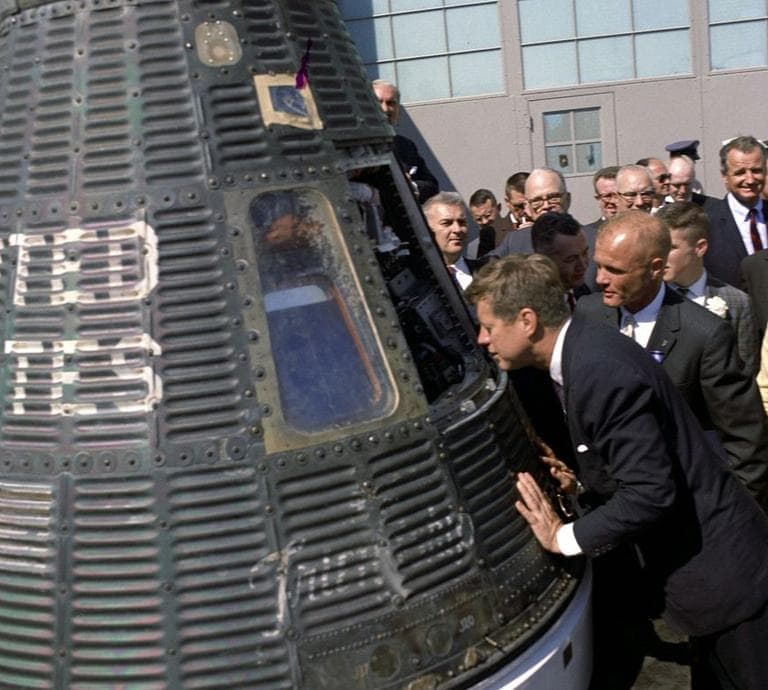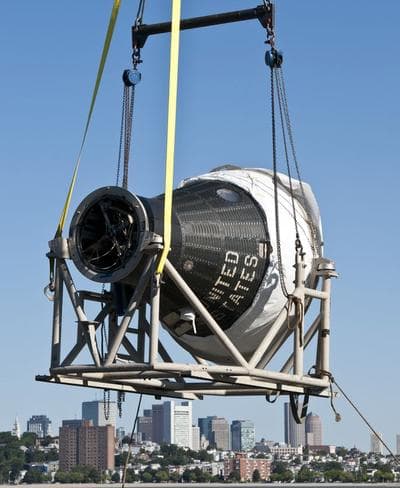Advertisement
'The Right Stuff': Freedom 7 Capsule On Display At JFK Library

It's a page out of "The Right Stuff."
The first American in space was Derry, N.H., native Alan Shepard. He was lobbed from Cape Canaveral in Florida 116 miles high aboard the Mercury capsule, the Freedom 7.
Now 51 years after the launch, that primitive spaceship will call Boston its home for the next three years. It's on display at Boston's John F. Kennedy Presidential Library & Museum.
The exhibit, which opened Wednesday, includes video of the launch and historic documents from the early days of the space race. Wednesday is also the 50th anniversary of an historic speech by President Kennedy at Rice University in Houston, outlining his bold proposition to send a man to the moon. An excerpt from the late president:

We set sail on this new sea because there is new knowledge to be gained, and new rights to be won, and they must be won and used for the progress of all people.
Standing in front of the capsule, WBUR spoke with JFK library Director Tom Putnam, who pointed out just how small the spacecraft is.
Tom Putnam: You can look in, you can see the seat that Alan Shepard sat in. You can see the control panels. People used to say that you didn't go into a space capsule, you wore it because it's so compact inside there.
Steve Brown: It's about the size of my SUV. Maybe a little bit smaller.
Right, yeah. Well, or like one of those little Smart cars that you see now — you know, you wonder how the people actually got inside.
Talk about the connection between the manned space program and President Kennedy. Shepard went up in that space capsule in May of 1961 — just about five months after JFK was inaugurated. So that was built before he came into office. But the space program is tied to President Kennedy.
He ran in the 1960 campaign that we were falling behind the Soviet Union in a number of ways. And one of them was in space. So the Soviets had put up Sputnik during the Eisenhower administration, and JFK wanted to catch up. During his first 100 days, the Soviets — Yuri Gagarin was the first man in space. And again, it was an example to JFK that we were falling behind.
This is the 50th anniversary of JFK's speech at Rice. Tell me about that; what was significant about that?
So there were, again, two speeches. The first one was when he was in Congress, which was just a few weeks after Alan Shepard went into space. And then he went to Rice University. As we all know, Texas had been really the center of where a lot of the space work was being done. So he went to Rice University and he gave this famous speech.
We choose to go to the moon in this decade and do the other things, not because they are easy, but because they are hard, because that goal will serve to organize and measure the best of our energies and skills, because that challenge is one that we're willing to accept, one we are unwilling to postpone, and one we intend to win, and the others, too.

So it was a way of galvanizing, especially not only those who were working on the projects — the scientists and engineers — but also to get the nation behind, because again, it was going to be a very costly investment of funds.
What were the scientists telling President Kennedy in 1961 and 1962 that led him to be able to make this statement, this bold challenge?
Well, his top advisers were telling him it couldn't be done. And there are plenty of memos where they said, "You know, this just isn't possible." And there's one kind of funny quip where an American physicist was asked what we would find when we got to the moon, and he said, "Russians." Because there was really a sense the Russians were ahead of us. Their space program was part of their military. They had unlimited resources. And they did a lot of their programs in secret. So even when Yuri Gagarin went around the world, that wasn't announced until afterwards.
President Kennedy took a very different strategy. First, our space program was separated from our military. Second, when Alan Shepard went up, all the press were there, so if it was a failure it would have been recorded. And really he was trying to bring out the best of the American people — the best of our scientists and engineers and our ingenuity, and really to compete with the Soviet Union head to head and to show that the American system — democratic, capitalistic system — could out-compete a command-control economy.
Advertisement
I remember growing up in the 1960s and '70s, and you couldn't tear yourself away from the television watching the space shots and the splashdowns and man walking on the moon and all of that. But has the charm of space kind of faded, and is that one of the reasons why you have this exhibit here?
Well we certainly want to inspire a new generation of Americans to be excited about science and technology, and that's one of the missions of this institution.
Alan Shepard, when he met President Kennedy, he said he was more nervous meeting President Kennedy than he was going up into space. And he said, you know, I just can't imagine a farm boy like me from New Hampshire getting all of this attention. So I think that story is an inspiring story — that a young boy who grew up in New Hampshire, studied science, went into the Navy, became a test pilot, that he could be the first American in space.
So we want young people to dedicate their talents to these monumental tasks, whether it's exploring the stars or eradicating disease. Those are the challenges that President Kennedy set for the nation, and we hope that people will continue to follow his legacy.
Freedom 7 will be on display at the John F. Kennedy Library & Museum until December 2015.
This program aired on September 12, 2012.